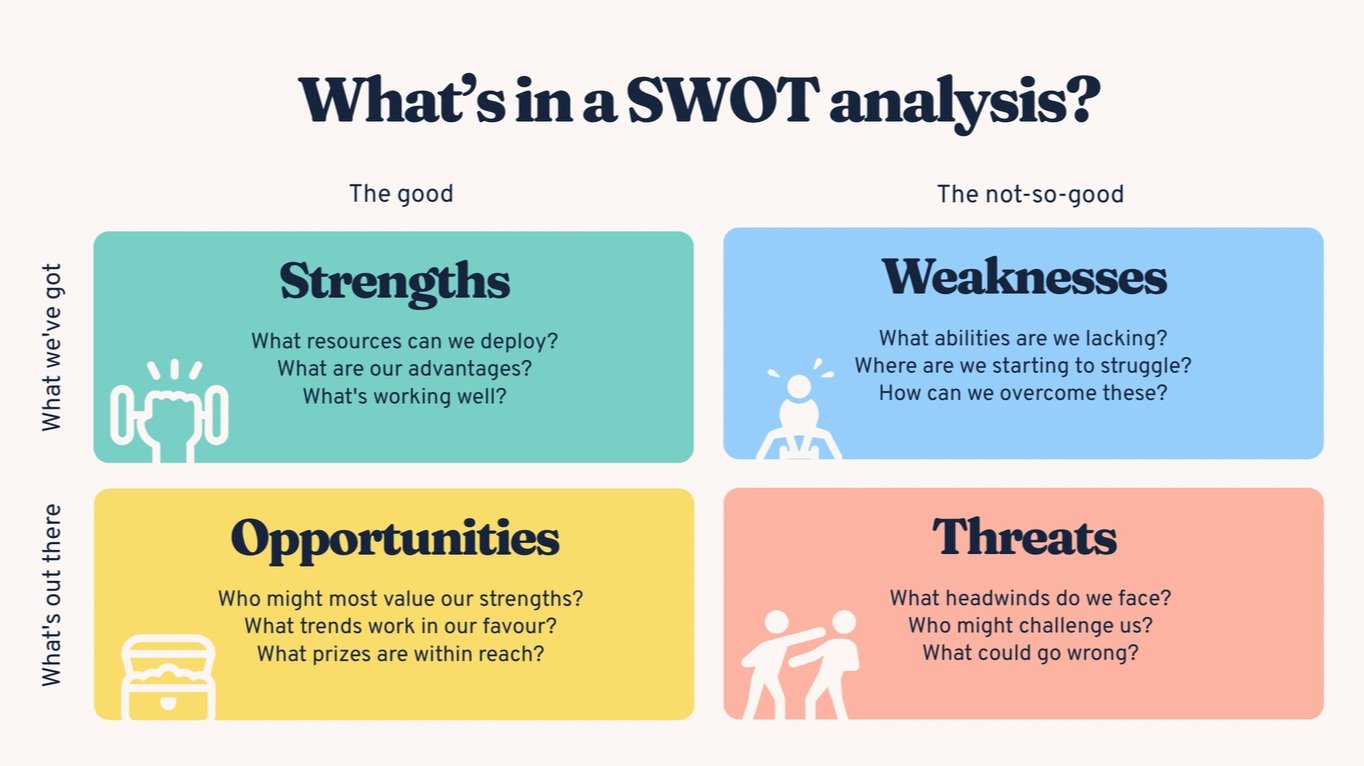How to Conduct a SWOT Analysis for Strategic Planning
How to Conduct a SWOT Analysis for Strategic Planning
When building a strategic plan, one of the most valuable tools for gaining a comprehensive view of your organization’s position in the market is the SWOT analysis. SWOT stands for Strengths, Weaknesses, Opportunities, and Threats, and it’s a foundational tool for understanding the internal and external factors that could influence your business’s success. In this blog, we’ll guide you through each step of conducting a SWOT analysis, offering tips to maximize its impact on your strategic planning process.
Why a SWOT Analysis?
A SWOT analysis helps you gain a 360-degree view of your organization by identifying both the positive and negative factors that could affect your success. This clarity is invaluable when developing a strategic plan, as it helps you make informed decisions, avoid potential pitfalls, and leverage your organization’s unique advantages.
Step 1: Preparing for Your SWOT Analysis
Before jumping into your analysis, gather input from multiple perspectives. Conducting a SWOT analysis as a team exercise can yield more well-rounded insights, as team members from different departments often bring unique views. In addition to your core team, you might consider feedback from:
Leadership team: Insights into long-term goals, resources, and challenges
Marketing and sales teams: Perspectives on market trends, customer feedback, and competition
Operational staff: Understanding of day-to-day challenges and workflow bottlenecks
Step 2: Identifying Strengths
Strengths are the internal attributes that give your company a competitive edge. They might include your unique expertise, resources, strong relationships, innovative products, or robust infrastructure. These are the areas where your organization excels and which can be leveraged to achieve strategic goals.
Questions to Ask:
What does our company do well?
What are our unique resources, assets, or skills?
How do we stand out from our competitors?
Which internal processes consistently produce positive outcomes?
Example:
If you’re a tech company, your strengths might include a talented development team, a well-established reputation, or strong brand loyalty among customers.
Step 3: Recognizing Weaknesses
Weaknesses are internal factors that could hold your organization back from achieving its full potential. Identifying these weaknesses allows you to address them proactively or mitigate their impact on your overall strategy.
Questions to Ask:
In which areas do we need improvement?
Are there gaps in our skill set or resources?
Which internal processes are inefficient or outdated?
What feedback have we received about our products or services that indicate room for improvement?
Example:
A retail business may have weaknesses like limited online presence or outdated inventory management software, which could hinder efficiency and customer satisfaction.
Step 4: Spotting Opportunities
Opportunities are external factors that could provide your organization with growth, expansion, or innovation possibilities. These could stem from market trends, technological advances, or regulatory changes that benefit your industry.
Questions to Ask:
Are there emerging market trends that align with our strengths?
Are there unmet needs among our customer base?
Are there new technologies or resources we could utilize?
Could changes in government policy positively impact our industry?
Example:
A healthcare company might see an opportunity in expanding telemedicine services due to increased demand for remote healthcare options.
Step 5: Identifying Threats
Threats are external factors that could pose challenges to your organization’s success. These could include economic downturns, changing customer preferences, increased competition, or shifts in regulations.
Questions to Ask:
Who are our main competitors, and what advantages do they have?
Are there external obstacles that could impact our ability to operate?
Are there market trends that could negatively affect our business?
How might economic conditions or regulatory changes impact us?
Example:
A small e-commerce brand might see large, well-funded competitors as a threat, as they may have more extensive marketing resources and greater reach.
Step 6: Analyzing and Acting on Your Findings
Once you’ve filled in each section, it’s time to analyze your findings. Here’s how to start transforming this information into an actionable strategy:
Leverage Strengths: Identify strategic initiatives that align with your strengths. For instance, if you have a loyal customer base, consider launching a referral program to encourage more brand advocates.
Address Weaknesses: Develop plans to improve or work around weaknesses. If, for example, your team lacks expertise in digital marketing, consider hiring a specialist or investing in training.
Seize Opportunities: Prioritize high-impact opportunities that align with your strengths and can address weaknesses. If there’s a trend you could capitalize on (e.g., sustainable products), develop a project plan to dive into that market.
Mitigate Threats: Formulate strategies to reduce the impact of potential threats. If new competition is a risk, focus on differentiating your brand by highlighting unique selling points (USPs).
Step 7: Integrating SWOT into Strategic Planning
Now that you have a clear understanding of your organization’s internal and external environment, you can incorporate your SWOT findings into your strategic planning process. Align specific goals with each category:
Strengths: Use them as the foundation for setting competitive advantages.
Weaknesses: Develop key performance indicators (KPIs) to address and track improvement in these areas.
Opportunities: Plan short- and long-term strategies to capture identified opportunities.
Threats: Outline contingency plans that address potential external risks.
Example SWOT Analysis for a Small Business
Strengths : Highly skilled team, strong customer relationships
Weaknesses: Limited marketing budget, outdated website
Opportunities: Growing demand in niche market, potential partnerships
Threats: New competitors, rising operational costs
Final Thoughts
A SWOT analysis is a straightforward yet powerful tool that can sharpen your strategic planning process. It provides a clear snapshot of your organization’s current state, helping you make informed decisions to support growth. By leveraging strengths, addressing weaknesses, seizing opportunities, and planning for threats, your business is well-equipped to build a robust and adaptive strategic plan.
Incorporate regular SWOT assessments to stay aligned with industry shifts, market trends, and internal developments. With this proactive approach, you’ll be better prepared to navigate challenges and capitalize on opportunities, positioning your organization for long-term success.
